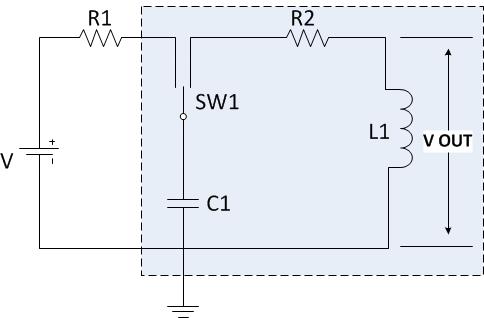Your circuit doesn't have a transfer function. What you can do is compute the output voltage \$v_{o}(t)\$ after the position of the switch is changed from \$R_1\$ to \$R_2\$. For convenience I use the symbols \$R=R_2\$, \$C=C_1\$, and \$L=L_1\$. I assume that the capacitor has been connected to the voltage source via \$R_1\$ for a sufficiently long time such that the voltage at the capacitor equals \$V\$. If the position of the switch is changed at time \$t=0\$, you get the following equation in the Laplace domain:
$$\frac{V}{s}=I(R+sL+1/sC)\tag{1}$$
where \$V\$ is the voltage at the capacitor at \$t=0\$, and \$I\$ is the current in the RLC circuit, such that the output voltage is given by
$$V_o=I\cdot sL\tag{2}$$
From (1) you get for the current
$$I=\frac{V}{L}\frac{1}{s^2+\frac{R}{L}s+\frac{1}{LC}}\tag{3}$$
which, combined with (2), gives for the output voltage \$V_0\$
$$V_0=V\cdot\frac{s}{s^2+\frac{R}{L}s+\frac{1}{LC}}=V\cdot\frac{s}{(s+\frac{R}{2L})^2+\frac{1}{LC}-\frac{R^2}{4L^2}}\tag{4}$$
The time domain function \$v_0(t)\$ is obtained by transforming (4) back to the time domain. Here you have to distinguish the following 3 cases, where I've used the symbols \$\alpha=R/2L\$ and \$\omega^2=\left|\frac{1}{LC}-\frac{R^2}{4L^2}\right|\$:
\$\frac{1}{LC}=\frac{R^2}{4L^2}\$:
$$V_0=V\frac{s}{(s+\alpha)^2}=V\left[\frac{1}{s+\alpha}-\frac{\alpha}{(s+\alpha)^2}\right]\Longleftrightarrow v_0(t)=V\left(1-\alpha t\right)e^{-\alpha t}u(t)$$
\$\frac{1}{LC}>\frac{R^2}{4L^2}\$:
$$V_0=V\frac{s}{(s+\alpha)^2+\omega^2}=V\left[\frac{s+\alpha}{(s+\alpha)^2+\omega^2}-\frac{\alpha}{(s+\alpha)^2+\omega^2}\right]\Longleftrightarrow \\v_0(t)=V\left[\cos(\omega t)-\frac{\alpha}{\omega}\sin(\omega t)\right]e^{-\alpha t}u(t)$$
\$\frac{1}{LC}<\frac{R^2}{4L^2}\$:
$$V_0=V\frac{s}{(s+\alpha)^2-\omega^2}=V\left[\frac{s+\alpha}{(s+\alpha)^2-\omega^2}-\frac{\alpha}{(s+\alpha)^2-\omega^2}\right]\Longleftrightarrow \\v_0(t)=V\left[\cosh(\omega t)-\frac{\alpha}{\omega}\sinh(\omega t)\right]e^{-\alpha t}u(t)$$

